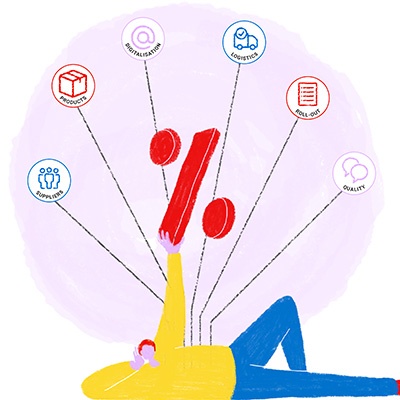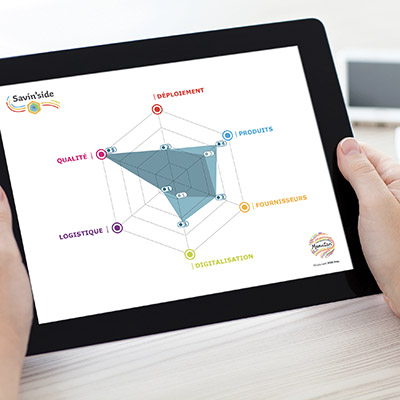For several years, the VUCA concept (Volatile, Uncertain, Complex and Ambiguous) dominated strategic discussions in companies. However, facing the acceleration of crises, a new framework has emerged: BANI, an acronym popularised by futurist Jamais Cascio. This acronym stands for Brittle, Anxious, Non-linear and Incomprehensible.
Whilst VUCA highlighted uncertainty, BANI goes further by emphasising the profoundly unstable and sometimes incomprehensible nature of the environments in which companies operate today. The BANI world concept helps us make sense of the complex reality around us, moving beyond the traditional VUCA world framework.
Definition and context of the BANI concept
BANI is an analytical framework that enables better understanding and anticipation of the new risks faced by organisations. It progressively replaces the VUCA model, deemed less relevant when facing the nature of current crises. The BANI world concept helps describe the world we're facing today, where traditional cause and effect relationships no longer apply in straightforward ways. Each letter carries a precise meaning:
- Brittle: systems, though appearing solid, can collapse brutally when faced with unforeseen disruptions;
- Anxious: constant uncertainty generates anxiety, affecting decision-making and team performance;
- Non-linear: events no longer follow logical progression; small changes can have disproportionate consequences;
- Incomprehensible: increasing complexity makes certain situations difficult to understand and anticipate.
This conceptual framework offers a more suitable reading grid for contemporary challenges than the VUCA model, particularly in today's world where climate change, war, and volatile systems create unprecedented uncertainty.
The impacts of the BANI world on business strategy
Operating in a BANI world necessitates a profound adaptation of strategic decisions. In this age of chaos, traditional approaches are no longer sufficient. Here are some major impacts:
- Decision-making: extreme uncertainty demands abandoning classical approaches and adopting more agile processes capable of reacting in real time. Leaders must prepare for the unexpected and avoid relying solely on long-term plans;
- Risk management: systemic fragilities require constant monitoring. A telling example is that of supply chains: a small defect at a single supplier can lead to complete breakdown. Supplier rationalisation becomes a priority, by diversifying sources and strengthening strategic partnerships;
- Organisational resilience: companies must be able to absorb shocks, whether health-related, geopolitical or economic. This requires implementing a clear code of conduct, robust business continuity plans, and integrating resilience at all organisational levels.
"The entire company must be engaged. What matters is understanding that this is a genuine systemic change - at all levels: on the side of leaders, companies, but also consumers. It's this global transformation that is essential." - Camille, COLBUS (Co-founder, Dero)[1]
Strategies and tools to strengthen resilience and agility in a BANI environment
Faced with fragility and unpredictability, companies must equip themselves with new strategies and innovative tools to secure their operations and gain agility. These tools help us navigate the brittle and incomprehensible nature of modern business environments.
Digital technologies: the foundation of adaptability
Digitalisation is no longer an option; it's a prerequisite for survival in a brittle and anxious environment. Digital transformation provides the systems companies need to thrive. Here are the main solutions to implement:
- Real-time monitoring: using platforms capable of ensuring monitoring of key pages, supplier contracts, stock levels, and even weak signals in markets. This enables detection of anomalies as soon as they appear and reaction before they transform into major crises. Example: implementing automatic alerts on critical price variations or delivery delays;
- Obtaining and managing strategic URLs: tools allowing obtaining the URL of each element (document, monitoring page, dashboard) facilitate traceability and reactivity. Thus, decision-makers access relevant information quickly without wasting time searching for sources;
- Uploading files, downloading code, creating books: it's essential to centralise strategic documentation. For example, grouping critical procedures, best practices, and checklists in file format or even as an internal book to capitalise on collective experience. These resources can be easily updated and shared between teams.
Supplier rationalisation: reducing fragility
Supplier diversity may seem synonymous with security, but in a non-linear world, too many partners without hierarchisation add complexity and weaken the whole. Future planning requires careful consideration of supplier relationships. Here are the steps to rationalise your supplier portfolio:
- Identify strategic partners: not all suppliers are equal. It's crucial to map dependencies, evaluate critical contributions, and prioritise those bringing real value;
- Reduce dependencies: by avoiding mono-dependencies (a single critical supplier), the risk of brutal breakdown is limited. Diversify, yes, but intelligently;
- Collaborate closely: in BANI logic, the link with suppliers must go beyond simple transactions. It involves establishing a shared code of conduct, co-constructing solutions, and continuously exchanging on observed weak signals.
Automation: shifting priorities
In an incomprehensible context, it's essential to free teams from repetitive, low-value tasks so they can focus on analysis and innovation. This approach helps companies make sense of chaotic situations:
- Automate critical operations: for example, automate stock management, demand forecasting, or strategic report generation. This enables shifting priorities by reducing decision-making delays;
- Intelligent alerts: implement alert systems based on personalised thresholds and non-linear data analysis. This reduces anxiety linked to manual monitoring and increases reactivity;
- Contractual flexibility: adapt supplier contracts to include rapid adjustment clauses in case of unforeseen events (for example, volume, deadline, or dynamic pricing clauses).
Documentation and knowledge sharing tools
For the entire organisation to be aligned, tools are needed that allow everyone to access strategic information:
- Download as PDF key reports to enable easy distribution within teams;
- Cite pages in reporting or monitoring documents to guarantee traceability and avoid information loss;
- Add a subject in collaborative spaces to launch collective reflection on weak signals or emerging trends;
- Make a donation: yes, even this action has a role in certain strategic contexts! For example, supporting local initiatives or innovative suppliers can strengthen essential links and position the company as an engaged stakeholder.
MediaWiki solutions and history management
In an environment where causes and effects are unclear, it's essential to maintain collective memory. Companies can use tools like MediaWiki to:
- View history of strategic decisions and actions, to understand what worked or not;
- To the bar of project navigation: create internal shortcuts to quickly access key pages;
- Upload a file or download the code of internally developed applications, to guarantee continuity in case of team or service provider changes.
Practical case: transforming procurement management facing BANI complexity
Faced with a BANI context, procurement management must be completely rethought to respond to extreme volatility and growing market complexity. Let's take the example of an industrial company confronted with the global shortage of electronic components. Facing the fragility of its supply chains, it chose to digitalise its entire procurement process, implementing a collaborative platform centralising supplier data, orders and contracts. This digitalisation enabled automation of repetitive tasks, improved stock visibility and anticipation of shortages through predictive analytics.
Simultaneously, the company rationalised its supplier panel, prioritising reliable strategic partners whilst diversifying its sources for each critical component. It also established continuous performance and risk evaluation, through regular audits and monitoring indicators. To limit dependence on international logistics chains, part of production was relocated to France, thus strengthening control of the value chain.
Finally, the company negotiated flexible contracts, including automatic revision clauses in case of force majeure, to secure its supplies whilst remaining agile facing market fluctuations. Thanks to this global strategy, the company maintained production continuity, reduced costs and strengthened its resilience.
Recommendations and best practices for strategic evolution
To succeed in a BANI world, it's not enough to adopt new tools: the corporate culture must also be transformed and all stakeholders involved. Companies must:
- Foster a culture of adaptability: encourage innovation and flexibility within teams;
- Invest in training: develop employees' skills to better manage uncertainty;
- Strengthen collaboration: establish solid partnerships with suppliers and stakeholders;
- Use advanced technological tools: integrate digital solutions to improve operational efficiency and resilience.
The BANI environment forces companies to rethink their strategies and develop increased adaptation capacity. By adopting innovative approaches, strengthening collaboration and investing in digitalisation, companies can not only survive but prosper in this complex and uncertain context. Understanding that we're no longer in a simple VUCA world but in something far more challenging is the first step towards effective adaptation.
[1] Camille, COLBUS (Co-founder, Dero), Le débat, SMART @WORK, 13 July 2024, 28 min, B-Smart, [https://www.bsmart.fr/video/24934-smart-work-13-juillet-2024]









